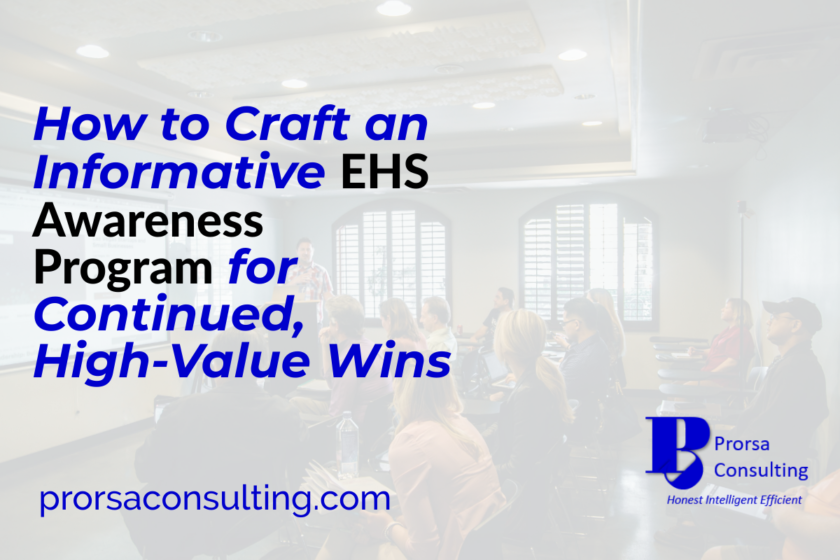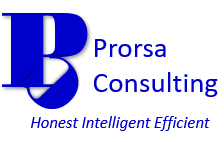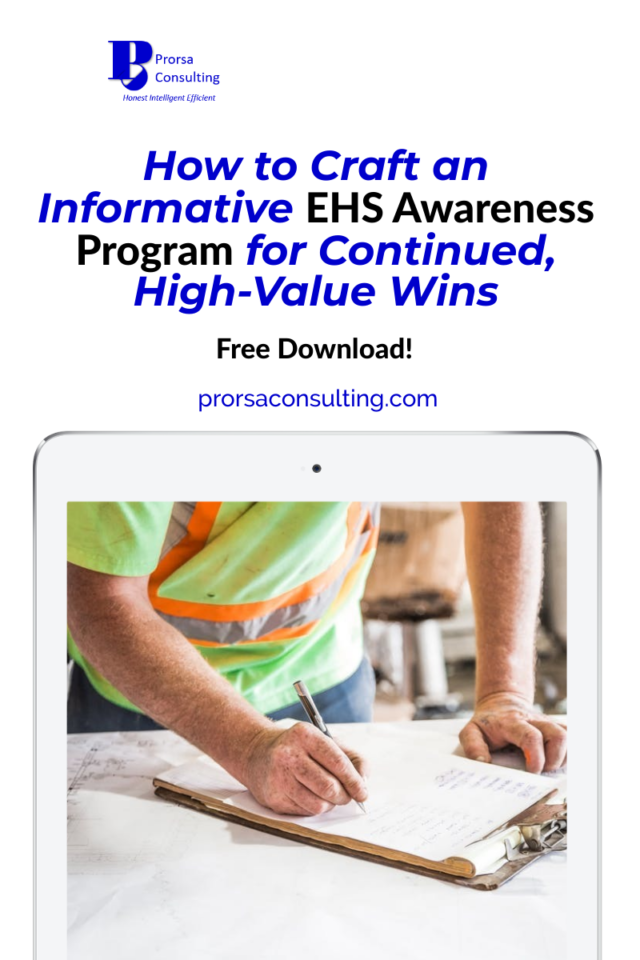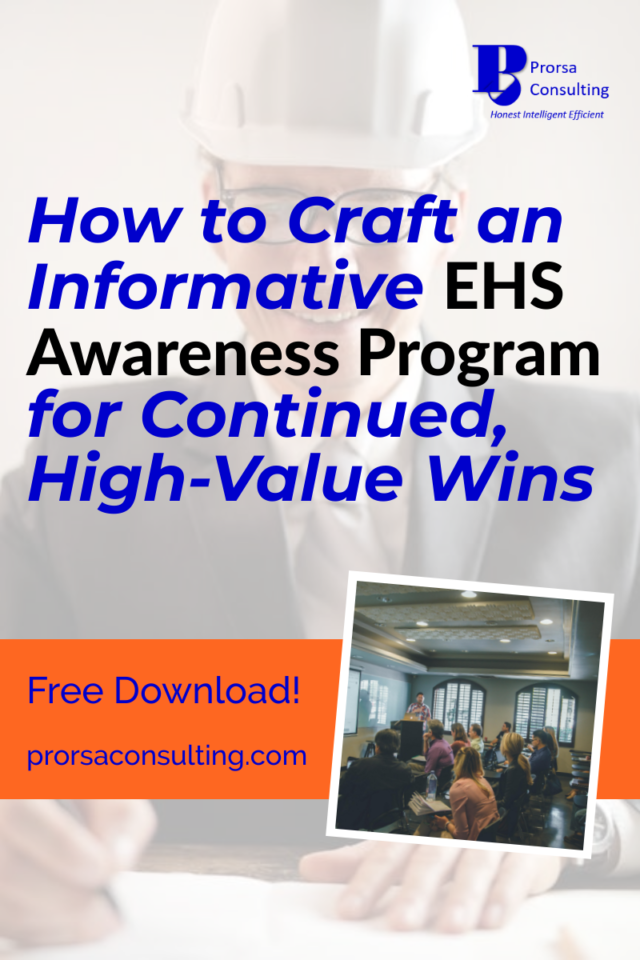How to Craft an Informative EHS Awareness Program for Continued, High-Value Business Wins
By : Admin -

Picture your current operation humming along with increased profits and improved morale thanks in part to an improved EHS Awareness Program.
At this point, you are probably a little skeptical because your EHS awareness program is part of a cost center, so it cannot positively impact the company’s bottom line.
However, this line of thinking is flat wrong if you want bigger, better business success.
The best-in-class companies often have killer environmental and safety training because they know excellent education drives worker engagement, satisfaction, and performance.
Furthermore, it makes perfect sense that organizations with high EHS performance would have already recognized the importance of environmental and safety awareness.
They have already used it to drive increased safety, environmental protection, and profitably, giving them a leg up on the competition.
So, are you ready to learn how to build an effective EHS Awareness Program to positively impact business outcomes?
Continue reading now.
Disclaimer: Please be aware that this blog post may contain affiliate links and any purchases made through such links will result in a small commission for Prorsa Consulting (at no extra cost for you). Feel free to visit our Disclosure of Material Connection page for more information.
EHS Awareness Program: The ‘Whys’ You May Not Have Thought About
We all know the biggest 2 ‘whys’ behind an EHS training program.
Number 1 . . . it’s usually required to have one to protect the business’s right to operate.
However, regulatory requirements serve as the minimum standard, i.e. a D+ student.
Is that the standard your business wants to set?
Number 2 . . . It’s is in the best financial interest for the business to protect its workers, its property, the environment.
Having to shell out money for worker injuries, property repairs, and/or environmental remediation can get costly fast.
EHS training helps support these efforts by imparting the knowledge employees need to keep themselves, property, and the environment safe.
Yet, the other ‘whys’ address vital intangibles needed to perform at a best-in-class level.
Properly constructed environmental training & safety awareness can encourage more worker engagement.
By increasing employees’ focus on improving weaknesses and taking ownership, they have more skin in the game.
Moreover, the rise in engagement in EHS has the potential to spill over into other areas of the business.
As workers engage in more positive ways, a rise in employee satisfaction often follows.
Increased worker motivation frequently accompanies this newfound employee pride.
Take a moment to think about it . . . aren’t you more apt to try a little harder at work when you happy within the workplace?
Of course, you are! And other employees feel the same way.
You can also expect absenteeism and work stress to decrease as worker satisfaction increases.
Earlier, we eluded to EHS training impacting worker performance to safeguard people, property, and the environment.
However, EHS training must close gaps in employees’ knowledge while fostering a gain in confidence and empowerment to perform at a best-in-class level.
Coupled with the increased engagement and satisfaction, heighten performance will feed productivity.
In the end, EHS training has left employees poised to achieve and nurture the desire to grow for bigger future success.

Image by Alexander Mils at Unsplash.com.
EHS Awareness Program: How It Can Truly Affect Your Bottom Line?
It is true . . . EHS is a cost center.
However, the smaller that cost center, the larger the profits for the organization.
Thus, companies with remarkable environmental and safety training tend to spend relatively less in the long run.
Not convinced? Well, check out the benefits that can be realized with a solid EHS training program:
- Better injury prevention, leading to decreased workers compensation claims and insurance premiums
- Avoidance of costly repairs from damaged equipment and the nonreporting of unsafe conditions
- More knowledgeable workers better able to assist the operation with EHS compliance, reducing money spent on fines
- Greater employee engagement and satisfaction, lowering absenteeism and workplace stress
- Presentation of a standardize EHS blueprint to guide workers’ tasks, helping to boost productivity

Image by Geralt on Pixabay.com.
EHS Awareness Program: Step 1 – How to Determine What Topics to Cover with Which Employees
Regulations, statues, and/or regulatory permits will mandate the majority of the contents in every EHS Awareness Program.
So, start the determination with a review of the rules, laws, and permits governing the facility.
Organizations may also want to add other EHS training topics deemed vital to operations.
These items are not mandated by regulation but provide important support to the site’s overall EHS program.
Examples would include the following:
- Internal safety rules
- Environmental and Safety Policy Statements
- Behavior Based Safety
- Personal Risk Assessment
- Available EHS Program Participation Opportunities
- EHS Program Feedback Mechanisms
Also, ask employees for feedback on what should be included in environmental training & safety training.
After all, workers put the training into practice, so their insights will prove invaluable.
All employees will not require EHS training for all topics identified.
For instance, it makes little sense to provide an office worker with forklift operator’s training.
An EHS awareness training matrix can map out what environmental and safety topics should be covered by whom and on what timeframe.
A matrix offers the flexibility of training identification by the individual or by job title.
Operations can customize it to the company’s unique set of workers and environmental and safety awareness topics.
The EHS Training Awareness Matrix standardizes and houses the information in one place for ease of use and efficiency.
Finally, the matrix costs little to nothing when developed in spreadsheet format.
EHS Awareness Program: Step 2 – Know Thy Audience and Meet It Where It Is
The notion of ‘meeting students where they are’ is a familiar concept to current and former educators, of which I am the latter.
The idea sets the expectation that a myriad of learning styles, knowledge, and ability levels can exist within a student body.
The duty falls to teachers to help students learn, despite the differences between pupils.
‘Meeting students where they are’ also applies to environmental training and safety training within the workplace.
For example, companies may have non-native English speakers as part of their workforces.
Additionally, some employees may learn best in a solo environment versus a classroom setting.
A portion of people can hear something once, comprehend it, and retain it while many others need to take it in visually before it sinks in.
In all these cases, offering flexibility in how EHS awareness content is presented would be prudent to ensure greater knowledge gains for workers.

Image by Product School at Unsplash.com.
A robust EHS Awareness Program incorporates these considerations as part of its design.
Training content must be conveyed in clear, concise language while avoiding complicated words.
Speak to the common man.
Plan to offer the training in languages other than English when necessary to facilitate the best understanding by students.
Incorporate multiple content delivery formats (classroom, computer-based, practice exercises, on-the-job, etc.) for environmental and safety awareness to address different learning styles.
Be intentional about including stories, humor, videos, other items to the design to teach while entertaining the audience.
Remember, once you lose the audience . . . it takes some work to get them back.
As such, organizations must plan to design EHS training to meet the needs and desires of the end users . . . employees.
EHS Awareness Program: Step 3 – Course Creation
Course creation entails the development of the training delivery system, whether it be PowerPoint presentation, video, audio recording, etc. for a particular topic.
Also, training materials like handouts, competency questions/tests, reference cards, etc. should be crafted during the course creation step.
Course creation can be completed externally as a standard package, externally as a custom product, or in-house.
Pros and cons exist with each scenario, which we explore in more detail below.
Many vendors offer standard training packages for classroom or computer-based training (CBT) delivery.
You can often mix or match topics as needed.
Pros of standard training packages:
- Save money over customized courses
- Avoid depleting in-house EHS personnel time with course development
- Get expertise beyond what may exist in-house, leading to higher quality product
- Provided in more formats than feasible to produce in-house, giving more flexibility for student learning
- Delivery and competency assessment usually included if CBT
Cons of standard training packages:
- Not customized to unique workforce or site conditions
- Lacks identified internally vital EHS topics
- Must vet vendor(s) to ensure reputable products/services
- Lacks a personal touch
- No control over content for future updates
If this course creation route seems to appeal to your particular organization, you can check out the standard packages offered by the merchants below.
I have evaluated and/or used in the past the two vendors below for EHS training:

Image by Proxyclick Visitor Management System at Unsplash.com.
Course creation externally as a customized product may cost a little more, but you receive content specifically aligned to your operation.
This usually leads to a more effective training product.
Pros of external custom product:
- Solidly resonates with employees due to internal staff input during the creation process
- Avoid depleting in-house EHS personnel resources with the creation efforts
- Get expertise beyond what may exist in-house, leading to higher quality product
- Control the specification of final products
- May be developed in more formats than feasible in-house
- Delivery, competency evaluations, record templates, program assessment templates, and future updates can be part of the scope
Cons of external custom product:
- Can be the most expensive option, but provides higher quality, more relevant products
- Must vet vendor(s) to ensure reputable products/services; look to external EHS consultant you trust and/or have worked with previously.
In-house course creation has the lowest monetary cost.
It also allows the organization to leverage its internal knowledge and experience to the fullest.
Pros of in-house course creation:
- Saves money
- Resonates best with employees with courses created by individuals most familiar with workforce and operations
- Total control over the content, as developed solely in-house
Cons of in-house course creation:
- Not all companies have dedicated EHS staff
- Drains internal time resources of the EHS staff if present, directing attention away from other compliance items
- Creation may require knowledge/skills not possessed internally
- May lose the option for multiple delivery formats due to internal resource constraints
In truth, many EHS Awareness Programs utilize all 3 of the course creation strategies to develop training content.
Regardless of the route your organization chooses, the following tips will help to ensure efficient course creation efforts, yielding satisfactory results:
- Gather all videos, images, audio files, support documents, etc. used to create training content in one place for easy access.
- Allow ample time for course creation. If creating in-house, be sure to dedicate time regularly to your schedule for the task.
- When working with external individuals on the effort, check-in for regular status updates and reviews.
- Accept and provide feedback to make the final product relevant and valuable to your company.
- If possible, review products for content, aesthetics, and style before they are finalized and accepted
- Tackle content creation in bite-sized portions to prevent strain on budgetary resources.

Image by Fred Kloet at Unsplash.com.
EHS Awareness Program: Step 4 – Implementation
No training program is complete without implementation.
Step 4 covers implementation in 4 subtasks:
- Delivery – the actual presentation of content to the learners
- Competency & Recordkeeping – the testing of students’ learning outcomes and recording the training as completed
- Program Assessment – soliciting feedback from participants on the programs’ effectiveness and gathering suggestions for improvements
- Continuous Improvement – making updates to program to ensure ongoing enhancement over time
When talking about environmental and safety training, the delivery can make you or break you.
As live, in-person training exists as an integral part of most EHS awareness programs, we will spend most of our time addressing delivery primarily in this format.
EHS training should be conducted by individuals with solid EHS knowledge and experience.
Trainers should have seen and done enough to answer student questions, which may require a deeper dive into information not emphasized in the training content.
Additionally, those chosen to deliver environmental and safety awareness sessions must be comfortable commanding an audience.
Speakers cannot display nervous, hesitant behavior. This undermines the audience’s trust in them as an expert authority.
Furthermore, trainers must be able to manage time well refocus the audience should the group stray too far on the topic at hand.
Even with the most experienced trainers, most adults find workplace training delivery in general boring and unnecessary.
So, have the trainer leverage the ‘entertainment pieces’ that should have been built into the training’s design.
Thus, the responsibility falls to the trainer to address these common concerns.
Moreover, individuals delivering EHS awareness content need to emphasize the importance of the training, making it personal for the trainees:
- Injury Prevention – we all want to go home each night in the same or better condition as we left in the morning.
- Environmental Protection – we have to protect the environment for our health and to continue to have the resources we need to produce our products and/or serve customers.
- Community Protection – our activities affect our neighbors and we must make sure they are not impacted negatively.
- Business Continuity – EHS impacts our bottom line and our right to stay open for business. Our paychecks depend on a stable, profitable company.
Strong environmental and safety training doesn’t neglect competency testing and recordkeeping.
Competency can be evaluated by written tests, scored exercises, oral question and answer, and numerous other methods.
The testing of competency should occur at frequent intervals throughout the training for the greatest effectiveness.
Any information shown to be confusing or not retained should be reviewed before the training’s end to ensure proper knowledge gain and reinforcement.
Concerning training records, the student(s) name, training date, length of training, course name, and trainer’s name must appear on the record, at a minimum.
Also, course content summaries and/or the course content should be retained as part of the official record.
In some cases, a training plan, formally detailing the EHS Awareness Program, may be warranted or mandated.
Businesses cannot know where to improve without focused efforts to assess environmental training and safety training.
Program assessments help identify what fixes can enhance effectiveness in the future.
These evaluations should include collecting feedback from participants on their experience with the program, such as:
- Usefulness of content – was it actionable, relevant, and clear?
- Speaker’s Rating – was he/she knowledgeable, easy to understand, good with time?
- Comfort of Surroundings – was the temperature comfortable, lighting satisfactory, set up appropriate for the content?
- Suggestions – what would you change to make the experience better in the future?
Feedback collection should be a standard part of the environmental and safety training’s delivery process.
Once this information gets collected, processed, and reviewed for trends, the creation of a roadmap to drive program improvement can commence.
Executing continuous improvement prevents you from leaving the EHS Awareness Program’s success solely to chance.
With the program evaluation results in hand, it’s time to develop a plan of action, or roadmap, to address the deficiencies.
The roadmap must record what needs to be accomplished, by what time, and by whom.
The action item matrix, as a spreadsheet, remains a favored way to accomplish this due to its ease of use and low cost.
However, automated task management systems like Asana and ClickUp offer free plans with greater features than a simple spreadsheet.
Remember to make improvement tasks feasible and get others involved with the updates.
The assessment data and changes in regulatory requirements should drive the frequency of improvements to environmental training and safety training.
However, some training sessions may garner few actionable suggestions or only identify easy fixes requiring little time.
If you find this is consistently the case, a periodic schedule (i.e. at least once every 3 years) for a more in-depth review and update may be warranted.
Finally, don’t neglect to perform training updates when the regulations affecting the facility change.
Struggling with your EHS Awareness Program design and implementation?
Contact Us today to request a free Discovery Call!
Other Articles Related to EHS Awareness Programs You May Like
Stop and Challenge Workers to Eat, Breathe, Live Home Safety Every Day – Part 1
Think You Know How to Execute an Effective EHS Management System Plan Stage?
Final Thoughts
Robust EHS Awareness Programs can increase worker satisfaction, engagement, and performance, leading to better business outcomes for the organization.
A program designed in the manner presented above does not have to break the bank.
In reality, the costs associated with a solid EHS Awareness Program should be viewed as an investment in your company’s future profitability and success.
We encourage your feedback on this blog. Be sure to like/and or share you enjoyed this article. You can also provide us feedback via our Contact Us page.
Don’t forget to follow Prorsa Consulting on LinkedIn, Pinterest, and Twitter.
How would you like to have access to additional, exclusive EHS updates & info from Prorsa Consulting? Just signup for the Prorsa Consulting Newsletter below. You’ll get access to our Free Resources area and all the tools, templates, and presentations in the library. Get your free subscription today!
How to Craft an Informative EHS Awareness Program for Continued, High-Value Business Wins





